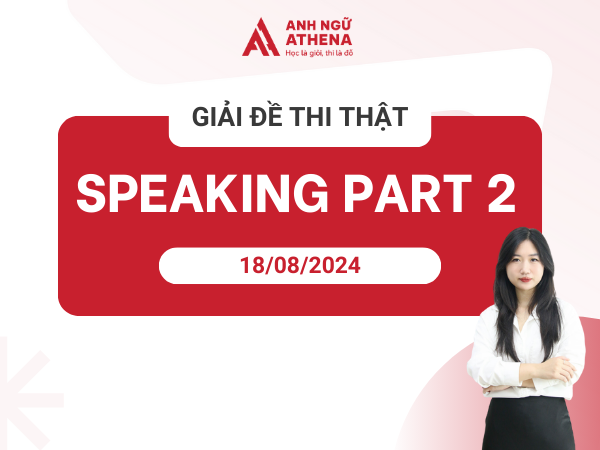IELTS Reading Passage là một phần thi quan trọng, thường bao gồm 14 dạng bài phổ biến như Matching Headings, True/False/Not Given, và Sentence Completion. Trong bài viết này, Athena sẽ cung cấp cho người đọc đề thi Reading IELTS thuộc các chủ đề phổ biến như Health and Fitness, Environment, Art, History, và Education.
Bên cạnh đó, Athena cũng sẽ phân tích đáp án chi tiết của các bài đọc để hỗ trợ quá trình ôn luyện của người học đạt hiệu quả tốt nhất.
Các dạng bài thường gặp trong Reading IELTS Passage
Khi luyện tập kỹ năng Reading IELTS Passage, người học sẽ thường gặp 14 dạng bài phổ biến. Mỗi dạng bài đòi hỏi các chiến lược và kỹ năng làm bài khác nhau. Dưới đây là danh sách các dạng bài và cách tiếp cận hiệu quả cho từng dạng:
- Matching Headings (Nối tiêu đề): Yêu cầu người học chọn tiêu đề phù hợp với ý chính của đoạn văn. Nên chú ý từ khóa và nắm rõ ý chính của từng đoạn trong IELTS Passage.
- Matching Paragraph Information (Nối thông tin đoạn văn): Yêu cầu xác định đoạn văn chứa thông tin được nêu trong câu hỏi. Khả năng skimming và scanning giúp xác định nhanh vị trí thông tin trong IELTS Passage.
- Matching Features (Nối đặc điểm): Nối các thông tin đặc điểm với các sự kiện hoặc phát ngôn liên quan. Cần cẩn thận khi liên kết thông tin từ IELTS Passage với câu hỏi.
- Matching Sentence Endings (Nối câu chưa hoàn chỉnh): Nối nửa câu đầu với nửa câu sau để tạo thành câu hoàn chỉnh. Đọc kỹ nửa câu đầu và tìm thông tin liên quan trong IELTS Passage là yếu tố quan trọng.
- True/False/Not Given or Yes/No/Not Given: Xác định thông tin trong câu hỏi có đúng với nội dung bài đọc hay không. Cần tập trung vào chi tiết để đưa ra kết quả chính xác trong IELTS Passage.
- Multiple Choice (Trắc nghiệm): Chọn đáp án đúng nhất từ các lựa chọn có sẵn. Đọc kỹ câu hỏi và lọc thông tin từ IELTS Passage giúp chọn đáp án chính xác.
- Choose a Title (Chọn tiêu đề): Chọn tiêu đề phù hợp nhất cho toàn bộ bài đọc. Khả năng tóm tắt ý chính của IELTS Passage hỗ trợ việc chọn tiêu đề đúng.
- Short Answer Questions (Câu hỏi trả lời ngắn): Trả lời câu hỏi trong khoảng 1-3 từ dựa trên thông tin tìm thấy trong IELTS Passage. Cần xác định đúng thông tin cần thiết cho câu trả lời ngắn.
- Sentence Completion (Hoàn thành câu): Điền từ vào chỗ trống để hoàn thành câu theo nội dung trong IELTS Passage. Khả năng xác định từ hoặc cụm từ phù hợp là cần thiết.
- Summary Completion (Hoàn thành đoạn tóm tắt): Tương tự như Sentence Completion, nhưng với phần tóm tắt một đoạn hoặc toàn bài. Cần tìm và điền từ thích hợp vào các chỗ trống trong phần tóm tắt của IELTS Passage.
- Table Completion (Hoàn thành bảng):Điền thông tin vào bảng dựa trên nội dung từ IELTS Passage. Khả năng đối chiếu chính xác giữa bài đọc và bảng thông tin là rất cần thiết.
- Flow Chart Completion (Hoàn thành biểu đồ):Điền vào các bước trong quy trình biểu đồ, dựa trên thông tin trong IELTS Passage. Kỹ năng đọc hiểu tốt và tóm tắt thông tin hỗ trợ làm dạng bài này.
- Diagram Completion (Hoàn thành sơ đồ):Điền từ vào chỗ trống trong sơ đồ dựa trên mô tả trong IELTS Passage. Hiểu rõ cấu trúc và chi tiết từ bài đọc giúp hoàn thành chính xác.
- Completion Diagrams (Hoàn thành biểu đồ): Hoàn thành biểu đồ dựa trên mô tả và hướng dẫn từ IELTS Passage. Việc hiểu sâu thông tin và điền từ đúng vào vị trí là yêu cầu chính.
Xem thêm: Luyện IELTS Reading ở đâu? Tổng hợp nguồn website, sách và đề luyện tập chất lượng
Các dạng bài tập thường xuất hiện trong bài Reading IELTS Passage
IELTS Passage: Bài đọc theo 5 chủ đề thông dụng kèm đáp án
IELTS Passage: Chủ đề Health and Fitness
Bài reading IELTS passage chủ đề Health and Fitness
The Benefits of Regular Physical Activity on Mental Health
Engaging in regular physical activity has long been associated with numerous physical health benefits, such as improved cardiovascular health, weight management, and reduced risk of chronic diseases. However, an often-overlooked advantage of regular exercise is its profound impact on mental health. Recent studies have demonstrated that individuals who incorporate consistent physical activity into their daily routines experience significant improvements in mood, cognitive function, and overall mental well-being.
One of the most immediate effects of physical activity on mental health is the release of endorphins, chemicals in the brain that act as natural mood lifters. Exercise triggers the production of these "feel-good" hormones, which help to reduce feelings of stress, anxiety, and depression. Moreover, engaging in activities such as running, swimming, or even walking can enhance self-esteem and provide a sense of accomplishment, contributing to a more positive self-image.
In addition to its emotional benefits, physical activity has been shown to improve cognitive function. Research indicates that regular exercise can enhance memory and concentration, thanks to increased blood flow to the brain. This is particularly important for older adults, as staying active can help to reduce the risk of cognitive decline and neurodegenerative diseases, such as Alzheimer’s disease. Furthermore, regular exercise promotes better sleep, which plays a crucial role in maintaining mental health by allowing the brain to rest and repair.
While physical activity offers many mental health benefits, the key to long-term success is consistency. Incorporating moderate-intensity activities like walking, cycling, or yoga into daily life can be enough to reap the rewards. For those who may struggle to find time, even small amounts of movement throughout the day can make a difference. The mental health benefits of exercise are cumulative, meaning that the more consistently one engages in physical activity, the greater the improvement in mental well-being.
Questions 1-5: True/False/Not Given
Do the following statements agree with the information in the passage?
Write True if the statement agrees with the information, False if the statement contradicts the information, or Not Given if there is no information on this.
- Regular exercise is only beneficial for physical health.
- Endorphins released during exercise help to improve mood.
- Physical activity has no impact on sleep quality.
- Exercise can reduce the risk of Alzheimer’s disease in older adults.
- Small amounts of physical activity have no effect on mental health.
Questions 6-9: Matching Features
Match each benefit with the corresponding result mentioned in the passage.
Write the correct letter A-D next to questions 6-9.
Benefits: A. Reduces stress and anxiety
B. Improves sleep quality
C. Enhances self-esteem
D. Prevents cognitive decline
- Exercise releases endorphins.
- Regular exercise increases blood flow to the brain.
- Physical activity helps individuals feel a sense of achievement.
- Consistent physical activity is important for mental well-being in old age.
Questions 10-13: Sentence Completion
Complete the sentences below with NO MORE THAN TWO WORDS from the passage.
- Physical activity triggers the production of __________ in the brain, which improve mood.
- Regular exercise helps prevent neurodegenerative diseases like __________.
- Engaging in physical activity helps to boost both memory and __________.
- The mental health benefits of exercise are cumulative, meaning they improve with __________.
Đáp án:
- False
- True
- False
- True
- False
- A
- D
- C
- D
- endorphins
- Alzheimer’s
- concentration
- Consistency
Hướng dẫn giải chi tiết:
1.Regular exercise is only beneficial for physical health.
- Trích dẫn: “However, an often-overlooked advantage of regular exercise is its profound impact on mental health.”
- Giải thích: Đoạn văn khẳng định rằng ngoài lợi ích về sức khỏe thể chất, còn có lợi ích cho sức khỏe tinh thần, nên câu hỏi không đúng.
- Đáp án: False
2.Endorphins released during exercise help to improve mood.
- Trích dẫn: “Exercise triggers the production of these ‘feel-good’ hormones, which help to reduce feelings of stress, anxiety, and depression.”
- Giải thích: Bài viết nói rõ rằng endorphins, các hormone được sản sinh trong quá trình tập thể dục, giúp cải thiện tâm trạng.
- Đáp án: True
3.Physical activity has no impact on sleep quality.
- Trích dẫn: “Furthermore, regular exercise promotes better sleep, which plays a crucial role in maintaining mental health...”
- Giải thích: Đoạn văn khẳng định rằng tập thể dục đều đặn cải thiện chất lượng giấc ngủ, do đó câu hỏi này sai.
- Đáp án: False
4.Exercise can reduce the risk of Alzheimer’s disease in older adults.
- Trích dẫn: “This is particularly important for older adults, as staying active can help to reduce the risk of cognitive decline and neurodegenerative diseases, such as Alzheimer’s disease.”
- Giải thích: Câu này đúng vì bài viết đề cập trực tiếp đến việc tập thể dục giúp giảm nguy cơ mắc bệnh Alzheimer ở người lớn tuổi.
- Đáp án: True
5.Small amounts of physical activity have no effect on mental health.
- Trích dẫn: “For those who may struggle to find time, even small amounts of movement throughout the day can make a difference.”
- Giải thích: Đoạn văn khẳng định rằng ngay cả những hoạt động nhỏ cũng có tác động tích cực đến sức khỏe tinh thần, do đó câu hỏi này sai.
- Đáp án: False
| Câu hỏi | Trích dẫn từ bài đọc | Đáp án | Giải thích |
| 6. Exercise releases endorphins. | “Exercise triggers the production of these ‘feel-good’ hormones, which help to reduce feelings of stress, anxiety, and depression.” | A | Tập thể dục kích thích sản sinh endorphins giúp giảm căng thẳng và lo âu. |
| 7. Regular exercise increases blood flow to the brain. | “Research indicates that regular exercise can enhance memory and concentration, thanks to increased blood flow to the brain.” | D | Tập thể dục thường xuyên cải thiện lưu thông máu đến não, ngăn ngừa suy giảm nhận thức. |
| 8. Physical activity helps individuals feel a sense of achievement. | “Moreover, engaging in activities such as running, swimming, or even walking can enhance self-esteem and provide a sense of accomplishment...” | C | Tham gia các hoạt động thể chất giúp nâng cao lòng tự trọng và cảm giác thành tựu. |
| 9. Consistent physical activity is important for mental well-being in old age. | “This is particularly important for older adults, as staying active can help to reduce the risk of cognitive decline...” | D | Tập thể dục đều đặn giúp người lớn tuổi duy trì sức khỏe tinh thần và giảm nguy cơ suy giảm nhận thức. |
| 10. Physical activity triggers the production of __________ in the brain, which improve mood. | “Exercise triggers the production of these ‘feel-good’ hormones...” | endorphins | Câu trả lời là "endorphins", các hormone này giúp cải thiện tâm trạng. |
| 11. Regular exercise helps prevent neurodegenerative diseases like __________. | “...reduce the risk of cognitive decline and neurodegenerative diseases, such as Alzheimer’s disease.” | Alzheimer’s | Bài viết đề cập trực tiếp đến bệnh Alzheimer, là một trong những bệnh thoái hóa thần kinh. |
| 12. Engaging in physical activity helps to boost both memory and __________. | “Regular exercise can enhance memory and concentration...” | concentration | Tập thể dục giúp cải thiện cả trí nhớ và khả năng tập trung. |
| 13. The mental health benefits of exercise are cumulative, meaning they improve with __________. | “The mental health benefits of exercise are cumulative, meaning that the more consistently one engages in physical activity...” | consistency | Lợi ích tinh thần của việc tập thể dục cải thiện khi người học thực hiện đều đặn. |
IELTS Passage: Chủ đề Environment
Bài reading IELTS passage chủ đề Environment
The Effects of Climate Change on Marine Life
Climate change is having a profound impact on marine ecosystems across the globe. Oceans cover more than 70% of the Earth’s surface and play a critical role in regulating the climate, absorbing carbon dioxide, and providing habitat for a vast array of species. However, rising global temperatures, ocean acidification, and the loss of sea ice are altering these vital ecosystems.
Warmer ocean temperatures affect marine species in various ways. For example, many fish species are migrating toward cooler waters, which can disrupt the balance of marine ecosystems. Coral reefs, which are among the most biologically diverse ecosystems on Earth, are particularly vulnerable to rising sea temperatures. Coral bleaching occurs when the symbiotic algae that provide coral with their vibrant colors and nutrients are expelled due to stress from warmer waters. If the water temperature remains high, the coral can die, leading to the collapse of entire reef ecosystems.
Another significant issue is ocean acidification, caused by increased levels of carbon dioxide (CO2) in the atmosphere. When CO2 is absorbed by seawater, it undergoes a chemical reaction that produces carbonic acid, which lowers the pH of the ocean. This process negatively impacts marine organisms, particularly those that rely on calcium carbonate for their skeletal structure, such as shellfish, sea urchins, and some species of plankton. As the ocean becomes more acidic, these organisms struggle to build and maintain their shells, which could have a cascading effect on the food web.
The reduction of sea ice is another consequence of climate change that is affecting marine life, particularly in the polar regions. Sea ice provides important habitat for species such as polar bears, seals, and penguins. As the ice melts earlier in the year and forms later, these species are left with less time to hunt, breed, and rear their young. The loss of sea ice also accelerates the warming of the Arctic region, as the dark ocean water absorbs more sunlight than the reflective ice, creating a feedback loop that exacerbates the problem.
Questions 1-5: True/False/Not Given
Do the following statements agree with the information in the passage?
Write True if the statement agrees with the information, False if the statement contradicts the information, or Not Given if there is no information on this.
- Oceans cover about 50% of the Earth’s surface.
- Fish migration due to rising ocean temperatures affects marine ecosystems.
- Coral bleaching is reversible once the water temperature decreases.
- Ocean acidification makes it easier for marine organisms to build shells.
- Polar bears are migrating to warmer regions due to the loss of sea ice.
Questions 6-8: Matching Headings
Choose the correct heading for paragraphs A, B, and C from the list of headings below.
List of Headings: i. The effects of ocean acidification on marine organisms
ii. The role of the ocean in climate regulation
iii. The impact of rising temperatures on coral reefs
iv. Marine species adapting to climate change
v. The consequences of sea ice reduction in the Arctic
- Paragraph A
- Paragraph B
- Paragraph C
Questions 9-13: Sentence Completion
Complete the sentences below with NO MORE THAN TWO WORDS from the passage.
- Coral reefs are home to some of the most __________ ecosystems on Earth.
- Coral bleaching happens when symbiotic algae are expelled due to __________.
- Ocean acidification occurs because of increased levels of __________ in the atmosphere.
- Marine organisms that rely on __________ for their skeletal structure are particularly affected by ocean acidification.
- The loss of sea ice accelerates Arctic warming due to the __________ of ocean water compared to ice.
Đáp án:
- False
- True
- False
- False
- Not Given
- ii
- iii
- v
- biologically diverse
- warmer waters
- carbon dioxide
- calcium carbonate
- dark color
Hướng dẫn giải chi tiết:
1.Oceans cover about 50% of the Earth’s surface.
- Trích dẫn: “Oceans cover more than 70% of the Earth’s surface…”
- Giải thích: Câu hỏi nói rằng đại dương chiếm khoảng 50% bề mặt Trái Đất, nhưng trong đoạn văn đã nói rõ là hơn 70%.
- Đáp án: False
2.Fish migration due to rising ocean temperatures affects marine ecosystems.
- Trích dẫn: “Warmer ocean temperatures affect marine species in various ways. For example, many fish species are migrating toward cooler waters, which can disrupt the balance of marine ecosystems.”
- Giải thích: Đoạn văn xác nhận việc cá di cư do nhiệt độ tăng làm gián đoạn cân bằng hệ sinh thái biển.
- Đáp án: True
3.Coral bleaching is reversible once the water temperature decreases.
- Trích dẫn: “If the water temperature remains high, the coral can die, leading to the collapse of entire reef ecosystems.”
- Giải thích: Đoạn văn không đề cập đến việc tẩy trắng san hô có thể phục hồi nếu nhiệt độ nước giảm. Thực tế, nếu nhiệt độ nước vẫn ở mức cao, san hô có thể chết.
- Đáp án: False
4.Ocean acidification makes it easier for marine organisms to build shells.
- Trích dẫn: “As the ocean becomes more acidic, these organisms struggle to build and maintain their shells…”
- Giải thích: Trái ngược với câu hỏi, axit hóa đại dương làm các sinh vật gặp khó khăn trong việc xây dựng và duy trì vỏ của chúng.
- Đáp án: False
5.Polar bears are migrating to warmer regions due to the loss of sea ice.
- Trích dẫn: Không có thông tin nào trong bài viết đề cập đến việc gấu Bắc Cực di cư đến vùng ấm hơn.
- Giải thích: Không có thông tin trong đoạn văn về việc này.
- Đáp án: Not Given
Câu 6 - 8
| Paragraph | Trích dẫn từ bài đọc | Heading phù hợp | Giải thích |
| Paragraph A | "Oceans cover more than 70% of the Earth’s surface and play a critical role in regulating the climate, absorbing carbon dioxide..." | ii. The role of the ocean in climate regulation | Đoạn A tập trung nói về vai trò của đại dương trong việc điều tiết khí hậu. |
| Paragraph B | "Coral reefs... are particularly vulnerable to rising sea temperatures. Coral bleaching occurs when..." | iii. The impact of rising temperatures on coral reefs | Đoạn B nói rõ tác động của nhiệt độ tăng đến rạn san hô và hiện tượng tẩy trắng san hô. |
| Paragraph C | "The reduction of sea ice is another consequence of climate change that is affecting marine life, particularly in the polar regions." | v. The consequences of sea ice reduction in the Arctic | Đoạn C đề cập đến hậu quả của việc mất băng biển ở Bắc Cực đối với đời sống sinh vật biển. |
| Câu hỏi | Trích dẫn từ bài đọc | Đáp án | Giải thích |
| 9. Coral reefs are home to some of the most __________ ecosystems on Earth. | "Coral reefs, which are among the most biologically diverse ecosystems on Earth..." | biologically diverse | Cụm từ "biologically diverse ecosystems" mô tả sự đa dạng sinh học của các rạn san hô. |
| 10. Coral bleaching happens when symbiotic algae are expelled due to __________. | "Coral bleaching occurs when the symbiotic algae... are expelled due to stress from warmer waters." | warmer waters | Hiện tượng tẩy trắng san hô xảy ra do nước ấm hơn. |
| 11. Ocean acidification occurs because of increased levels of __________ in the atmosphere. | "Ocean acidification... caused by increased levels of carbon dioxide (CO2) in the atmosphere." | carbon dioxide | Axit hóa đại dương xảy ra do sự gia tăng mức CO2 trong khí quyển. |
| 12. Marine organisms that rely on __________ for their skeletal structure are particularly affected by ocean acidification. | "particularly those that rely on calcium carbonate for their skeletal structure..." | calcium carbonate | Các sinh vật phụ thuộc vào canxi cacbonat cho cấu trúc xương bị ảnh hưởng bởi axit hóa. |
| 13. The loss of sea ice accelerates Arctic warming due to the __________ of ocean water compared to ice. | "The loss of sea ice also accelerates the warming... as the dark ocean water absorbs more sunlight than the reflective ice." | dark color | Mất băng biển làm gia tăng nhiệt độ Bắc Cực do nước biển màu tối hấp thụ nhiều ánh sáng hơn so với băng phản chiếu. |
IELTS Passage: Chủ đề Art
Bài reading IELTS passage chủ đề Art
The Evolution of Modern Art
The term "modern art" refers to artistic works produced during the period roughly extending from the 1860s to the 1970s, and it signifies a departure from traditional styles and techniques. During this era, artists sought to break away from the rigid conventions of the past and embraced experimentation with color, form, and subject matter. This period saw the emergence of iconic art movements, including Impressionism, Cubism, and Surrealism, each of which challenged the norms of art in its own unique way.
One of the most notable changes in modern art was the shift from realistic representation to abstraction. For centuries, artists had focused on creating works that depicted the world around them as accurately as possible. However, modern artists began to reject this approach, seeking instead to explore the emotional and psychological aspects of their subjects. For example, in the early 20th century, the Cubist movement, led by artists like Pablo Picasso and Georges Braque, deconstructed objects into geometric shapes, representing multiple perspectives within a single image.
Impressionism, which emerged in the late 19th century, was another key movement that revolutionized the art world. Artists like Claude Monet and Edgar Degas rejected the detailed realism of earlier works in favor of capturing fleeting moments and the effects of light. Their works were characterized by loose brushwork and vibrant colors, creating a sense of movement and spontaneity that was unprecedented in the art world.
Surrealism, which developed in the 1920s, took abstraction to a new level by exploring the unconscious mind. Influenced by the theories of Sigmund Freud, surrealist artists like Salvador Dalí and René Magritte created dreamlike scenes that blurred the lines between reality and fantasy. Their works often depicted bizarre, illogical landscapes and figures, challenging viewers to question their perceptions of reality.
While modern art was initially met with resistance by traditionalists, it has since become a defining aspect of cultural heritage. Today, many of the artists and movements that were once considered radical are celebrated as pioneers who expanded the boundaries of artistic expression.
Questions 1-5: Multiple Choice
Choose the correct answer A, B, C, or D for each question.
- What does the term "modern art" primarily signify?
A. Art produced in the 18th century
B. A departure from traditional art styles
C. Art that focuses solely on realism
D. A continuation of classical techniques - How did Cubist artists like Picasso and Braque change traditional art?
A. They focused on creating realistic landscapes.
B. They used geometric shapes to represent multiple perspectives.
C. They exclusively painted abstract portraits.
D. They returned to classical forms of art. - What was a key feature of Impressionist paintings?
A. Detailed realism and historical subjects
B. Strict adherence to classical techniques
C. Capturing the effects of light and movement
D. Monochrome color schemes - Which of the following is true about Surrealism?
A. It emphasized strict realism.
B. It was influenced by the theories of Sigmund Freud.
C. It focused only on landscapes and nature.
D. It had no connection to abstract art. - What is suggested about modern art in the last paragraph?
A. It is no longer appreciated in contemporary society.
B. It continues to face resistance from traditionalists.
C. It is now regarded as a significant part of cultural heritage.
D. It has had little impact on the art world.
Questions 6-10: Matching Information
Match each movement (6-10) with its corresponding description (A-F).
Write the correct letter A-F next to questions 6-10.
Descriptions: A. Artists focused on depicting realistic details with accuracy.
B. A movement that explored the unconscious mind and dreamlike scenes.
C. Works characterized by loose brushwork and vibrant colors.
D. A focus on emotional and psychological aspects of subjects.
E. Artists broke objects into geometric shapes to show multiple perspectives.
F. A return to classical and traditional artistic methods.
Movements:
- Impressionism
- Cubism
- Surrealism
- Realism
- Abstract Expressionism
Questions 11-13: Summary Completion
Complete the summary using NO MORE THAN TWO WORDS from the passage.
Modern art, emerging between the 1860s and 1970s, marked a shift from traditional art. It involved experimentation with form, color, and subject matter. (11)_________, for example, focused on capturing moments through loose brushwork and vibrant colors, while (12)_________ deconstructed objects into geometric shapes to show multiple perspectives. Later, (13)_________ artists explored the unconscious mind, often producing dreamlike and surreal scenes.
Đáp án
- B
- B
- C
- B
- C
- C
- E
- B
- A
- D
- Impressionism
- Cubism
- Surrealist
Hướng dẫn giải chi tiết:
- What does the term "modern art" primarily signify?
- Trích dẫn: "The term 'modern art' refers to artistic works produced during the period roughly extending from the 1860s to the 1970s, and it signifies a departure from traditional styles and techniques."
- Giải thích: Modern art đánh dấu sự thay đổi từ các phong cách nghệ thuật truyền thống.
- Đáp án: B
- How did Cubist artists like Picasso and Braque change traditional art?
- Trích dẫn: "Cubist movement, led by artists like Pablo Picasso and Georges Braque, deconstructed objects into geometric shapes, representing multiple perspectives within a single image."
- Giải thích: Cubist sử dụng các hình khối hình học để thể hiện nhiều góc nhìn trong cùng một bức tranh.
- Đáp án: B
- What was a key feature of Impressionist paintings?
- Trích dẫn: "Their works were characterized by loose brushwork and vibrant colors, creating a sense of movement and spontaneity..."
- Giải thích: Một đặc điểm quan trọng của tranh ấn tượng là tập trung vào ánh sáng và chuyển động.
- Đáp án: C
- Which of the following is true about Surrealism?
- Trích dẫn: "Surrealism, which developed in the 1920s, took abstraction to a new level by exploring the unconscious mind... Influenced by the theories of Sigmund Freud..."
- Giải thích: Chủ nghĩa siêu thực chịu ảnh hưởng từ lý thuyết của Sigmund Freud về tiềm thức.
- Đáp án: B
- What is suggested about modern art in the last paragraph?
- Trích dẫn: "While modern art was initially met with resistance by traditionalists, it has since become a defining aspect of cultural heritage."
- Giải thích: Nghệ thuật hiện đại hiện nay được công nhận là một phần quan trọng của di sản văn hóa.
- Đáp án: C
| Câu hỏi | Trích dẫn từ bài đọc | Đáp án | Giải thích |
| 6. Impressionism | "Impressionism... rejected the detailed realism of earlier works in favor of capturing fleeting moments and the effects of light." | C | Phong trào ấn tượng nổi bật với việc ghi lại khoảnh khắc ngắn và hiệu ứng ánh sáng. |
| 7. Cubism | "The Cubist movement... deconstructed objects into geometric shapes, representing multiple perspectives within a single image." | E | Chủ nghĩa lập thể phá vỡ các đối tượng thành hình học để thể hiện nhiều góc nhìn. |
| 8. Surrealism | "Surrealism... created dreamlike scenes that blurred the lines between reality and fantasy." | B | Chủ nghĩa siêu thực khai thác tiềm thức và tạo ra những cảnh mơ màng. |
| 9. Realism | Không có trích dẫn từ bài | A | Realism tập trung vào chi tiết thực tế với độ chính xác. |
| 10. Abstract Expressionism | Không có trích dẫn từ bài | D | Chủ nghĩa biểu hiện trừu tượng tập trung vào khía cạnh cảm xúc và tâm lý. |
| 11. Impressionism | "Impressionism... capturing fleeting moments and the effects of light." | Impressionism | Trường phái ấn tượng tập trung vào các khoảnh khắc thoáng qua. |
| 12. Cubism | "The Cubist movement... deconstructed objects into geometric shapes, representing multiple perspectives..." | Cubism | Chủ nghĩa lập thể phá vỡ các đối tượng thành hình học. |
| 13. Surrealist | "Surrealist artists like Salvador Dalí... created dreamlike scenes that blurred the lines between reality and fantasy." | Surrealist | Nghệ sĩ siêu thực khai thác tiềm thức để tạo ra các cảnh mơ màng. |
IELTS Passage: Chủ đề History
Bài reading IELTS passage chủ đề History
The Rise and Fall of the Roman Empire
The Roman Empire, which began as a small city-state in Italy, grew to dominate much of Europe, North Africa, and the Middle East. It lasted for over a thousand years, with its influence still felt in modern times. The expansion of Rome can be attributed to its powerful army, effective governance, and strategic location. However, despite its long-lasting dominance, the Roman Empire eventually fell in 476 AD, a collapse caused by a combination of internal decay and external pressure.
One of the key reasons for Rome's expansion was its military prowess. The Roman army was highly disciplined and organized, using advanced strategies that allowed it to defeat larger armies. Roman soldiers were well-trained and loyal to the state, ensuring that the empire could maintain control over its vast territories. Additionally, Rome had a policy of incorporating conquered peoples into its army, granting them citizenship and land in exchange for their service.
In terms of governance, Rome was also highly effective. The Roman Republic, which preceded the Empire, established a system of checks and balances that prevented any single individual from gaining too much power. However, as the empire grew, so did corruption and political instability. By the 3rd century AD, Rome was plagued by a series of weak emperors, civil wars, and economic crises. These issues weakened the empire from within, making it more vulnerable to external threats.
The external pressures on the Roman Empire came in the form of barbarian invasions. Germanic tribes, such as the Visigoths and Vandals, took advantage of Rome’s internal instability and invaded its territories. In 410 AD, the Visigoths sacked Rome, and by 476 AD, the last Roman emperor, Romulus Augustulus, was deposed, marking the official end of the Western Roman Empire. While the Eastern Roman Empire, known as the Byzantine Empire, continued to exist for another thousand years, the fall of Rome symbolized the beginning of the Middle Ages in Europe.
Despite its fall, the legacy of the Roman Empire can still be seen today. Roman law, architecture, and engineering have had a lasting influence on Western civilization. The use of Latin as a foundation for many modern languages, the Roman alphabet, and the concept of republicanism are just a few of the contributions that have shaped the modern world.
Questions 1-5: Sentence Completion
Complete the sentences using NO MORE THAN THREE WORDS from the passage.
- The Roman Empire controlled parts of Europe, North Africa, and the __________.
- The Roman military was successful due to its discipline and __________.
- Roman soldiers were rewarded with __________ for their service.
- The Roman Empire began to weaken due to internal decay and __________.
- The Visigoths sacked Rome in __________.
Questions 6-10: Summary Completion
Complete the summary below with words from the passage.
The Roman Empire grew from a small city-state into a vast empire because of its strong military and effective government. Roman soldiers were highly trained and __________ (6), allowing them to control vast territories. However, by the 3rd century AD, the empire began to experience __________ (7) due to weak leadership and political instability. This internal decay made Rome vulnerable to __________ (8) from Germanic tribes like the Visigoths. In 476 AD, the last Roman emperor was deposed, marking the __________ (9) of the Western Roman Empire. Despite its fall, Rome's influence is still evident today in areas like __________ (10), law, and architecture.
Questions 11-13: Matching Statements with Events
Match the statements (11-13) with the correct event from the passage (A-D). Write the correct letter A-D next to the statement.
Statements:
11. The Roman Empire expanded due to its military and government.
12. The Roman Empire experienced political instability and corruption.
13. The fall of Rome marked the beginning of the Middle Ages.
Events:
A. The fall of Romulus Augustulus
B. The sacking of Rome by the Visigoths
C. The beginning of the Roman Republic
D. The expansion of the Roman Empire
Đáp án:
- Middle East
- advanced strategies
- citizenship and land
- external pressure
- 410 AD
- disciplined
- internal decay
- invasions
- end
- language
- D
- C
- A
Hướng dẫn giải chi tiết:
- The Roman Empire controlled parts of Europe, North Africa, and the __________.
- Trích dẫn: "The Roman Empire... grew to dominate much of Europe, North Africa, and the Middle East."
- Giải thích: Đoạn văn nói rõ rằng Đế chế La Mã kiểm soát cả châu Âu, Bắc Phi và Trung Đông.
- Đáp án: Middle East
- The Roman military was successful due to its discipline and __________.
- Trích dẫn: "The Roman army was highly disciplined and organized, using advanced strategies that allowed it to defeat larger armies."
- Giải thích: Quân đội La Mã nổi tiếng về kỷ luật và chiến lược tiên tiến.
- Đáp án: advanced strategies
- Roman soldiers were rewarded with __________ for their service.
- Trích dẫn: "Rome had a policy of incorporating conquered peoples into its army, granting them citizenship and land in exchange for their service."
- Giải thích: Binh lính La Mã được thưởng quốc tịch và đất đai để đổi lấy sự phục vụ.
- Đáp án: citizenship and land
- The Roman Empire began to weaken due to internal decay and __________.
- Trích dẫn: "These issues weakened the empire from within, making it more vulnerable to external threats."
- Giải thích: Đế chế La Mã suy yếu bởi sự mục nát bên trong và áp lực từ bên ngoài.
- Đáp án: external pressure
- The Visigoths sacked Rome in __________.
- Trích dẫn: "In 410 AD, the Visigoths sacked Rome..."
- Giải thích: Người Visigoths cướp phá Rome vào năm 410 SCN.
- Đáp án: 410 AD
| Câu hỏi | Trích dẫn từ bài đọc | Đáp án | Giải thích |
| 6. Roman soldiers were highly trained and __________. | "Roman soldiers were well-trained and loyal to the state..." | disciplined | Quân lính La Mã được đào tạo tốt và có kỷ luật cao. |
| 7. The empire began to experience __________. | "By the 3rd century AD, Rome was plagued by a series of weak emperors, civil wars, and economic crises." | internal decay | Đế chế bắt đầu suy yếu bởi sự suy tàn từ bên trong. |
| 8. Rome was vulnerable to __________ from Germanic tribes like the Visigoths. | "Germanic tribes... took advantage of Rome’s internal instability and invaded its territories." | invasions | Các bộ tộc German xâm lược khi Đế chế La Mã trở nên yếu đuối. |
| 9. The fall of the Western Roman Empire marked the __________. | "By 476 AD, the last Roman emperor... was deposed, marking the official end of the Western Roman Empire." | end | Sự sụp đổ của Đế chế La Mã phương Tây đánh dấu sự kết thúc. |
| 10. Rome's influence is still evident today in areas like __________. | "Roman law, architecture, and engineering have had a lasting influence on Western civilization." | language | Di sản La Mã vẫn tồn tại trong các ngôn ngữ hiện đại. |
| 11. The Roman Empire expanded due to its military and government. | "The expansion of Rome can be attributed to its powerful army, effective governance, and strategic location." | D (The expansion of the Roman Empire) | Đế chế La Mã mở rộng nhờ quân đội hùng mạnh và quản lý hiệu quả. |
| 12. The Roman Empire experienced political instability and corruption. | "By the 3rd century AD, Rome was plagued by a series of weak emperors, civil wars, and economic crises." | C (The beginning of the Roman Republic) | Đế chế La Mã gặp phải bất ổn chính trị và tham nhũng trong giai đoạn đầu của nền Cộng hòa. |
| 13. The fall of Rome marked the beginning of the Middle Ages. | "The fall of Rome symbolized the beginning of the Middle Ages in Europe." | A (The fall of Romulus Augustulus) | Sự sụp đổ của Rome đánh dấu sự khởi đầu của thời Trung Cổ ở châu Âu. |
IELTS Passage: Chủ đề Education
Bài reading IELTS passage chủ đề Education
The Evolution of Distance Learning
Distance learning, a concept that allows students to study without being physically present in a traditional classroom, has evolved dramatically over the past few decades. Initially, distance learning was limited to correspondence courses, where students received and submitted their assignments via mail. However, with the advent of the internet, online education has transformed into a sophisticated system, providing learners with access to virtual classrooms, interactive materials, and instant communication with instructors and peers.
One of the main advantages of distance learning is its flexibility. Students can access course materials at any time, allowing them to balance their education with work, family, and other commitments. This model has opened the door for many individuals who otherwise would not have had the opportunity to pursue higher education. Additionally, distance learning has made education more accessible to students in remote or underdeveloped regions where educational institutions may not be readily available.
Despite its many advantages, distance learning also presents some challenges. One significant drawback is the lack of face-to-face interaction, which can lead to feelings of isolation among students. Many learners find it difficult to stay motivated without the structure and social aspects of a traditional classroom environment. Furthermore, not all students have access to reliable technology or the internet, particularly in developing countries, creating a "digital divide" that exacerbates educational inequality.
Nonetheless, advancements in technology continue to improve the distance learning experience. Modern platforms offer features such as live video lectures, real-time discussions, and collaborative tools, which help to replicate the dynamics of a physical classroom. Furthermore, artificial intelligence (AI) is being integrated into educational platforms to provide personalized learning experiences, adaptive assessments, and instant feedback, making distance learning more efficient and engaging.
As the world becomes more interconnected, the demand for flexible, accessible education continues to grow. Distance learning is likely to remain a crucial component of the global educational landscape, offering new opportunities for learners across the globe.
Questions 1-5: Classification
Classify the following characteristics as applying to:
A. Correspondence courses
B. Online education
C. Both types of distance learning
Write the correct letter A, B, or C next to each statement.
- Assignments are sent and received through the mail.
- Allows students to interact with instructors and peers in real time.
- Provides flexibility for students with work or family commitments.
- Can lead to feelings of isolation among learners.
- Requires reliable access to technology and the internet.
Questions 6-10: Matching Sentence Endings
Complete each sentence with the correct ending, A-F, below.
Write the correct letter A-F next to questions 6-10.
Endings:
A. offer features such as live video lectures and real-time discussions.
B. receive instant feedback and adaptive assessments.
C. struggle to stay motivated without structure.
D. allows students to balance education with other commitments.
E. could help reduce feelings of isolation.
F. requires students to be physically present in a classroom.
Sentences:
- Distance learning has evolved with the internet to include virtual classrooms that...
- One of the challenges of distance learning is that many students...
- AI technology is helping to make distance learning more engaging by allowing students to...
- The flexibility of distance learning is one of its main advantages because it...
- Collaborative tools and live discussions in online platforms...
Questions 11-13: True/False/Not Given
Do the following statements agree with the information in the passage?
Write True if the statement agrees with the information, False if the statement contradicts the information, or Not Given if there is no information on this.
- Distance learning was first introduced as online education in the 1990s.
- The digital divide affects access to distance learning for students in developing countries.
- Traditional classrooms are expected to disappear as distance learning becomes more popular.
Đáp án:
- A
- B
- C
- C
- B
- A
- C
- B
- D
- E
- False
- True
- Not Given
Hướng dẫn giải chi tiết:
- Assignments are sent and received through the mail.
- Trích dẫn: "Initially, distance learning was limited to correspondence courses, where students received and submitted their assignments via mail."
- Giải thích: Việc nhận và gửi bài tập qua đường bưu điện thuộc loại hình học từ xa truyền thống (correspondence courses).
- Đáp án: A
- Allows students to interact with instructors and peers in real time.
- Trích dẫn: "Online education has transformed into a sophisticated system, providing learners with access to virtual classrooms, interactive materials, and instant communication with instructors and peers."
- Giải thích: Học trực tuyến hiện đại (online education) cho phép tương tác trực tiếp với giáo viên và bạn học.
- Đáp án: B
- Provides flexibility for students with work or family commitments.
- Trích dẫn: "One of the main advantages of distance learning is its flexibility. Students can access course materials at any time, allowing them to balance their education with work, family, and other commitments."
- Giải thích: Cả học từ xa truyền thống và trực tuyến đều mang lại sự linh hoạt trong việc học.
- Đáp án: C
- Can lead to feelings of isolation among learners.
- Trích dẫn: "One significant drawback is the lack of face-to-face interaction, which can lead to feelings of isolation among students."
- Giải thích: Cả hai hình thức học từ xa đều có thể khiến người học cảm thấy cô lập vì thiếu tương tác trực tiếp.
- Đáp án: C
- Requires reliable access to technology and the internet.
- Trích dẫn: "Not all students have access to reliable technology or the internet, particularly in developing countries, creating a 'digital divide'..."
- Giải thích: Học trực tuyến đòi hỏi người học phải có công nghệ và internet đáng tin cậy.
- Đáp án: B
| Câu hỏi | Trích dẫn từ bài đọc | Đáp án | Giải thích |
| 6. Distance learning has evolved with the internet to include virtual classrooms that... | "Online education has transformed into a sophisticated system, providing learners with access to virtual classrooms, interactive materials, and instant communication..." | A | Học từ xa hiện đại bao gồm các lớp học ảo với các buổi giảng dạy và tương tác trực tiếp. |
| 7. One of the challenges of distance learning is that many students... | "Many learners find it difficult to stay motivated without the structure and social aspects of a traditional classroom environment." | C | Người học gặp khó khăn khi thiếu cấu trúc và tương tác xã hội của lớp học truyền thống. |
| 8. AI technology is helping to make distance learning more engaging by allowing students to... | "AI is being integrated into educational platforms to provide personalized learning experiences, adaptive assessments, and instant feedback." | B | Trí tuệ nhân tạo giúp học tập từ xa trở nên hấp dẫn hơn bằng cách cung cấp phản hồi tức thì. |
| 9. The flexibility of distance learning is one of its main advantages because it... | "One of the main advantages of distance learning is its flexibility. Students can access course materials at any time, allowing them to balance their education with work, family, and other commitments." | D | Sự linh hoạt của học từ xa cho phép người học cân bằng giữa học tập và các trách nhiệm khác. |
| 10. Collaborative tools and live discussions in online platforms... | "Modern platforms offer features such as live video lectures, real-time discussions, and collaborative tools, which help to replicate the dynamics of a physical classroom." | E | Các công cụ hợp tác và thảo luận trực tuyến giúp giảm cảm giác cô lập cho người học. |
11. Distance learning was first introduced as online education in the 1990s.
- Trích dẫn: "Initially, distance learning was limited to correspondence courses, where students received and submitted their assignments via mail."
- Giải thích: Học từ xa bắt đầu bằng hình thức thư tín, không phải trực tuyến, nên câu này sai.
- Đáp án: False
12. The digital divide affects access to distance learning for students in developing countries.
- Trích dẫn: "Not all students have access to reliable technology or the internet, particularly in developing countries, creating a 'digital divide'..."
- Giải thích: Sự chênh lệch công nghệ và internet ảnh hưởng đến khả năng tiếp cận học từ xa, đặc biệt ở các nước đang phát triển.
- Đáp án: True
13. Traditional classrooms are expected to disappear as distance learning becomes more popular.
- Trích dẫn: Không có thông tin trong đoạn văn đề cập đến việc các lớp học truyền thống sẽ biến mất.
- Giải thích: Không có thông tin đề cập đến sự biến mất của lớp học truyền thống.
- Đáp án: Not Given
Luyện tập Reading IELTS Passage cùng anh ngữ Athena
Trên đây là 5 bài đọc IELTS Passage theo các chủ đề phổ biến thường gặp được biên soạn bởi đội ngũ Athena kèm hướng dẫn chữa bài chi tiết. Ngoài các bài đọc trên, người học có thể bạn cũng có thể cân nhắc luyện tập reading IELTS Passage Online tại trang Online Test của website anhnguathena.vn. Bên cạnh đó, người học có thể ôn luyện hiệu quả hơn khi tham gia khóa học IELTS toàn diện từ mất gốc cam kết đầu ra 6.5-7.5+ của Athena giúp bạn tăng điểm 4 kỹ năng nhanh chóng:
- Lộ trình học “tối giản”, “tối ưu” giúp bạn nắm vững kiến thức cơ bản, và nắm chắc tấm bằng IELTS 6.5-7.5+ trong tầm tay.
- Được giảng dạy trực tiếp bởi ThS. Đỗ Vân Anh (8.5 IELTS, 9.0 Listening với 10 năm kinh nghiệm giảng dạy TOEIC/IELTS).
- Được chữa Speaking 1-1 trực tiếp hàng tuần cùng Cô Vân Anh - “Đặc quyền” chỉ có tại khóa học của Athena.
- Học phí “nhẹ ví” với các bạn sinh viên: Khóa IELTS từ mất gốc đến 7.0+ tại Athena là lựa chọn phù hợp với các bạn sinh viên mong muốn sở hữu tấm bằng IELTS với chi phí thấp - chất lượng cao. Ngoài ra, Athena còn trao học bổng định kỳ với các bạn học viên hoàn thành tốt chương trình học.
Thông tin chi tiết về khoá học IELTS từ 0 đạt 6.5 - 7.5+ của Athena TẠI ĐÂY.
Xem thêm:
- Top 12 bài đọc IELTS theo các band điểm từ 0 - 7.5+
- [PDF + Review] Bộ tài liệu Basic IELTS Reading
- Tổng hợp bộ 1000+ từ vựng IELTS 5.0 - 6.5+ và nguồn sách tham khảo














![[Cập nhật] Lịch thi TOEIC 2025 Quý 1 tại IIG Việt Nam](https://anhnguathena.vn/upload/ban-sao-cua-template-bai-viet-seo-6.png?v=1.0.0)





